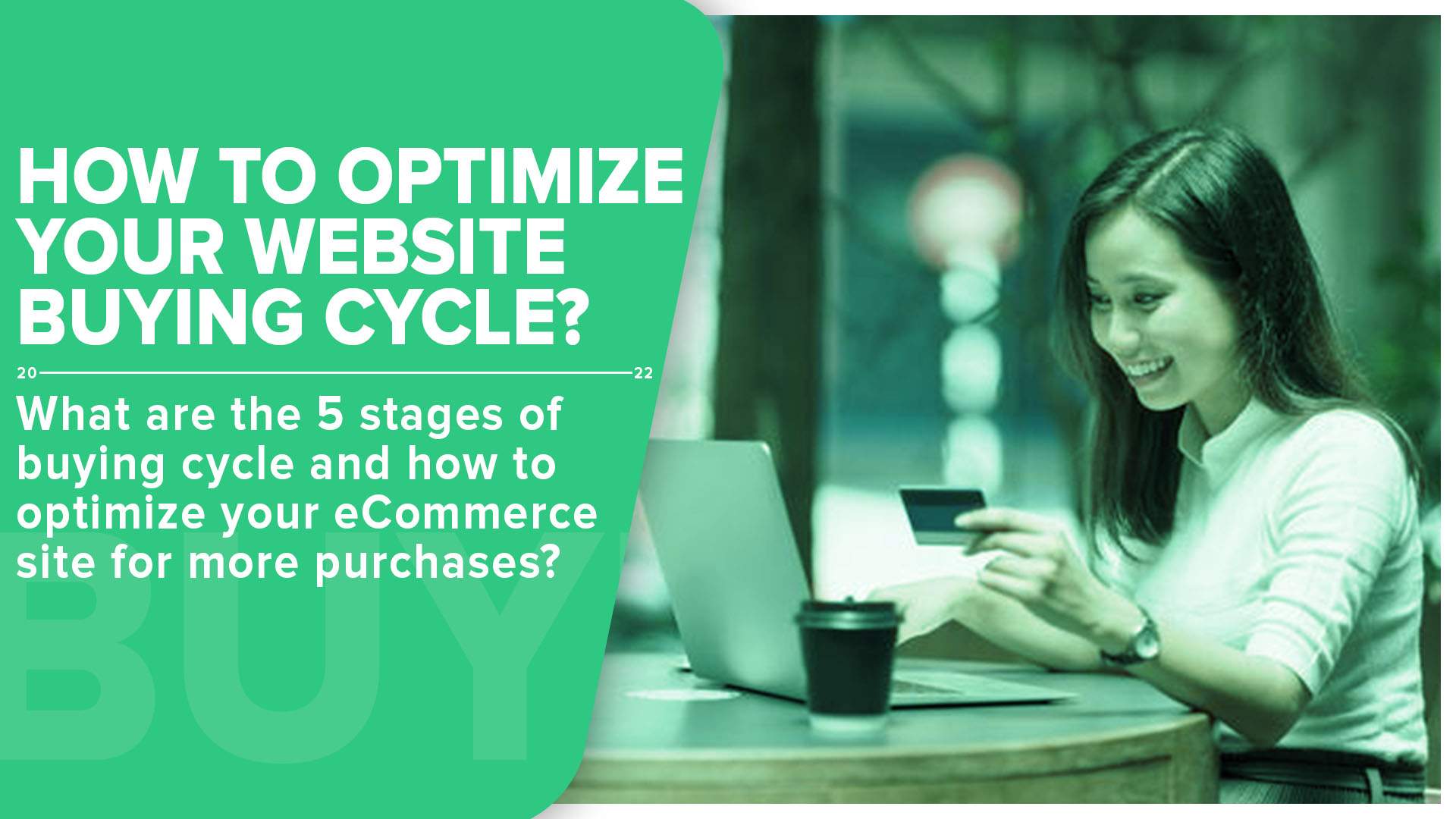
If you have been into business for a while, you might know the truth – You can’t force consumers to buy from you!
In these tough competitive times, no matter how impressive your website is, how awesome your offers are, or how effective your conversion methods are – you cannot convert an unwilling customer to spend money and purchase your product.
Now you might think – Why not? What is going wrong?
Well, to understand this, businesses need to understand the customer buying cycle. If you can know your customers, you can easily find out what they need, why they didn’t make the purchase, and what will make them change their decision or come back in the future.
In this article, we have curated steps that will help you to optimize your site according to the customer buying cycle. The guide will also help you align your marketing strategies and sales process, increase your retention rate and decrease your selling expense.
Lastly, if you are a branding agency, this article will be useful to help your clients convert visitors and generate more purchases.
What is buying cycle?
The buying cycle is also known as the sales cycle. It is a 5-stage process that every consumer goes through before making the purchase. The cycle helps businesses understand the market demand and sell the right product to the right customer at the right time. The five distinct stages are –
- Awareness
- Consideration
- Intent
- Purchase
- Revisit/Renewal
The eCommerce buying cycle is no different than the original buying cycle. But because it’s online, eCommerce businesses have to take the help of social media, email, and other digital marketing tools to sell to consumers and close sales for new/recurring customers.
Consumers go through different stages during their purchasing process as they research before considering making the final purchase.
Mapping the buyer journey is crucial for any business to convert the vast percentage of their website visitors and effectively move them closer to the next stage in the funnel. Based on the cycle, you can plan focused marketing campaigns, generate more leads, and identify future growth opportunities.
Remember, you can’t control the customer journey, but you can efficiently make it easy for them through proper planning.
Let’s go through each phase of the sales funnel in depth.
The 5 stages of Buying Cycle
1. Awareness
In the awareness stage, the customer tries to understand their need or problem that needs a solution. In this phase, customers lack meticulously detailed problem statements and seek information.
As a company, your goal should be to identify their needs and make customers aware that you can solve them with a proper solution. Make full use of your marketing strategies to reach new customers and help them move to the next stage in the journey.
Knowledge sharing and the Intent of the seeker – are the key here. You can use your website, social media platforms, and blog posts to make consumers aware of your solution, product, or service.
2. Consideration
In the consideration stage – Sellers should make efforts to make an effective impact on the buyers. With the limited market size, customers evaluate their available options based on their needs and wants.
Your content marketing strategies should focus on how to meet these needs best. An informational and solution-focused approach will be the best bet for this buying cycle phase. Display the USPs of your brand, understand their demand, introduce new features and values, and focus on user experience for engaging on-page content.
Use videos, testimonials, detailed visuals, case studies, and infographics, and create relevant landing pages, eBooks, guides, and free demos or consultations to appeal to potential buyers to consider your company.
3. Intent
This is the stage where the customer finally narrows their options and decides which solution is best for them. So far, your strategies have been fluid, moving the customer to the next stage smoothly. You successfully persuaded the customer that your product was the best choice.
Based on your consistent solution-focused engagement approach, you can now lead consumers to make a purchase. This is when your salesperson can make a difference and create urgency by offering discounts, limited-time offers, and giveaways to expedite the buying process.
Make sure the checkout process is smooth. Show your customers you are the best in business through different campaigns and proof of work to make them move to the final stage in the funnel.
4. Purchase stage
This is the stage where the customer is ready to buy. Your solution-focused content marketing strategies have pushed them to this culminating point. But remember, a potential buyer can only become your loyal customer when they have purchased from you.
So, now as a seller, it’s your job to make the process as seamless as possible. Optimize your site for conversion by optimizing buy now CTAs, and streamlining the pricing page and shopping cart – basically making the customers feel safe and like a king.
Ensure no surprises in the end, like extra fees or delivery and shipping complexities. Improve every aspect of the purchase journey to make the checkout process as effortless as possible.
Your job isn’t done yet! If a buyer is at a retention stage, the business must keep engaging with the users to create loyalty and maintain customer satisfaction. This will keep them coming back to your business, renew your subscription, or make another purchase.
5. Repurchase stage
Purchase is not the conclusion of the journey. Customer fulfillment, customer assistance, and customer retention go hand in hand. Consumers buy from you as they start trusting you.
Design your marketing strategy to engage with the loyal customer. Prioritize improving your customer service at every touch point. Nurture the relationship that you have developed with the new customers that will help you in customer retention and referral from your existing customers.
Why is eCommerce Buying Cycle So Important?
Reducing attention span and hybrid environment, fueled by a rapid shift in digital buying behavior and dynamics, has forced businesses to redefine their sales strategy.
According to a recent study by Gartner, over 70% of the consumer’s buying process has already been done before they even contact a salesperson. Sellers have tiny windows and fewer opportunities to influence their buying decision.
Hence, businesses must add additional efforts through different touchpoints at each stage of the buying journey.
One must remember – the path from the Awareness to the Decision stage is not always a predictable process. Therefore, understanding the buying cycle can assist you in setting business goals and developing a marketing plan to encourage consumers to choose your brand repeatedly.
Engaging with the consumers emotionally is vital if we want to gain new/recurring customers. As a business, it’s your job to efficiently guide consumers at each stage of their journey.
You can use different tools like Google Analytics, Survey Monkey, and more to gather all the information on your consumers. You can then map this buyer’s journey to make a customer-focused plan to drive more sales.
It is important to know with so many different businesses, different goals, and different motivations – there can’t be one way of doing things. The buying journey can help you develop more personalized strategies in a rewarding way.
How to optimize the site for each stage of the buying process?
From the right content to visuals to the right keywords – finding a balance between giving your customer the right information at the right stage without overwhelming them is the key. You can optimize your website step-by-step for each stage in the buying cycle.
Awareness Stage
Your primary goal is to attract users to land on your site with accurate information. You can implement direct conversion-friendly strategies to increase actionable awareness.
For example, you can leverage different social media platforms to generate engagement with your brand. Social media analytics will help you measure how many of those engagements directly or indirectly interact with your brand and how many led to an increase in revenue.
Online advertising, like PPC campaigns, pop-up ads, Google Ads, mobile ads, or retargeting campaigns, can also be one of your primary weapons to spread awareness to larger audiences.
Influencer marketing has gained popularity recently, which can also help you attract and create brand awareness.
Consideration/Intent Stage
Once you have piqued visitors’ interest through your marketing efforts, your goal is to address any uncertainties at this stage. The objective is to provide a solution to their problem and confidently move them to the next buying stage.
Use lead magnets and clear call-to-actions to grab the prospect’s attention. Attention span is limited, so make it count!
Do A/B testing, use bold – compelling images, use color theory to highlight buttons/pop-ups/offers, and experiment with different fonts. Basically, grab people’s attention to tell your brand story loud and clear.
Evaluate your unique selling point and ensure this is clearly communicated on your website. Why should the customer pick you over others? Be clear about your intention, highlight your USP to reinforce your decision, and back your story with testimonials and customer reviews.
Optimize each page and be minimal about your navigation bar. Eliminate unnecessary clicks and get the user straight to what they want.
You can also stimulate users’ intent with other relevant product information or recommendations. Nurturing your prospects might kindle their curiosity about your brand and thus help increase sales.
Purchase stage
This is the stage where your customer finally decides to buy your product. Hence, it’s your job to make the experience seamless!
Create a perfect checkout experience leaving no stone unturned. If customers are abandoning your cart at the end, remind them through email marketing, SMS, and push notifications. You can also do A/B testing to create an uninterrupted and optimal checkout flow.
Repurchase stage
Loyalty is the key to repeat purchases. Implement loyalty programs to reward your customers for each purchase.
Use email marketing, push notifications, and SMS to target people who have already filled form and opted in. Social media is a great way to interact with your customers and engage with them faster.
You can also entice customers with offers and discounts to make them purchase again, especially attract temporarily inactive users.
The buyer Cycle is a linear process where every stage is interconnected. Experimenting and optimizing one stage can directly or indirectly impact the other stage. Understanding the entire buyer’s cycle and mapping it correctly will help you become successful.
Conclusion
Businesses worldwide have been competing for users’ attention since the dawn of time. Evolving technology, seismic shift in the consumer’s buying behavior, and fierce competition has increasingly made it difficult for businesses to get their message across.
Through the above guide, you can effectively develop your sales funnel to combat the competition and stand out.
Whether you want your customer to purchase your product online, sign up for your educational course, donate money, or choose any solution, leveraging the customers’ buying cycle is the key to a successful online business.
So, what are you waiting for? Start mapping your buyer’s journey with your marketing plan today! And before you know it, you will generate more leads, newer opportunities, and more people coming back again and again!




